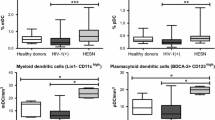Abstract
Background
Dendritic cells (DCs) promote pathogen recognition, uptake and presentation of antigen through DC-specific intercellular adhesion molecule 3-grabbing non-integrin (DC-SIGN) and toll-like receptors (TLRs).
Aims and Objectives
We aimed to study temporal changes in DCs, TLRs and DC-SIGN during acute viral hepatitis B (AVHB) infection and compare them to chronic (CHB) and to investigate the earliest time point of activated pathogen recognition receptors in hepatitis B viral infection.
Methods
We measured the frequencies of circulating myeloid (mDC) and plasmacytoid (pDC) dendritic cells and IFN-α production along with the expression of DC-SIGN and Toll Like Receptors (TLR's) in HBV patients at different time points. Also investigated in healthy volunteers, the dynamic changes in TLRs expression after receiving hepatitis B vaccine.
Results
On follow-up of AVHB patients, we found the mDC population was significantly higher at week 4 and 6 (p < 0.02, 0.01), whereas the pDC population was unchanged at week 6 compared with week 0. Whereas frequencies of mDCs and pDCs were found to be elevated in AVHB and CHB patients than HC (p < 0.00 and 0.01, respectively) but was comparable among AVHB vs CHB. The DCs in CHB patients were functionally impaired with significantly low IFN-α production and low DCSIGN expression (p < 0.04 and 0.00, respectively). Even after stimulation by TLR agonists, no change was found in IFN-α production in CHB patients. MyD88 and IL-6, IFN-α mRNA levels were also found down-regulated. Interestingly, on follow-up after HBV vaccine, TLRs expression was found high at day 3 after vaccination.
Discussion
The initial events of immune activation might be responsible for modulating immune response. These novel observations would pave the way for the development of antiviral strategies for chronic HBV infection.






Similar content being viewed by others
References
Lavanchy D. Worldwide epidemiology of HBV infection, disease burden, and vaccine prevention. J Clin Virol 2005;34(Suppl 1):S1–S3
Guidotti LG, Chisari FV. Immunobiology and pathogenesis of viral hepatitis. Annu Rev Pathol 2006;1:23–61
Chisari FV. Hepatitis B virus transgenic mice: models of viral immunobiology and pathogenesis. Curr Top Microbiol Immunol 1996;206:149–173
Revill P, Yuan Z. New insights into how HBV manipulates the innate immune response to establish acute and persistent infection. Antivir Ther 2013;18(1):1–15
Chang JJ, Lewin SR. Immunopathogenesis of hepatitis B virus infection. Immunol Cell Biol 2007;85(1):16–23
Koziel MJ. The immunopathogenesis of HBV infection. Antivir Ther 1998;3(Suppl 3):13–24
Han Q, Zhang C, Zhang J, Tian Z. The role of innate immunity in HBV infection. Semin Immunopathol 2013;35(1):23–38
Usharauli D. Dendritic cells and the immunity/tolerance decision. Med Hypotheses 2005;64(1):112–113
Liu YJ. Dendritic cell subsets and lineages, and their functions in innate and adaptive immunity. Cell 2001;106(3):259–262
Kadowaki N, Ho S, Antonenko S, Malefyt RW, Kastelein RA, Bazan F, et al. Subsets of human dendritic cell precursors express different toll-like receptors and respond to different microbial antigens. J Exp Med 2001;194(6):863–869
Wang M, Zou X, Tian D, Hu S, Jiang L. Role of dendritic cell-specific ICAM-3-grabbing nonintegrin on dendritic cells in the recognition of hepatitis B virus. Viral Immunol 2015;28(6):331–338
Arima S, Akbar SM, Michitaka K, Horiike N, Nuriya H, Kohara M, et al. Impaired function of antigen-presenting dendritic cells in patients with chronic hepatitis B: localization of HBV DNA and HBV RNA in blood DC by in situ hybridization. Int J Mol Med 2003;11(2):169–174
van der Molen RG, Sprengers D, Binda RS, de Jong EC, Niesters HG, Kusters JG, et al. Functional impairment of myeloid and plasmacytoid dendritic cells of patients with chronic hepatitis B. Hepatology 2004;40(3):738–746
Webster GJ, Reignat S, Maini MK, Whalley SA, Ogg GS, King A, et al. Incubation phase of acute hepatitis B in man: dynamic of cellular immune mechanisms. Hepatology 2000;32(5):1117–1124
Zhang F, Ren S, Zuo Y. DC-SIGN, DC-SIGNR and LSECtin: C-type lectins for infection. Int Rev Immunol 2014;33(1):54–66
Said A, Weindl G. Regulation of Dendritic Cell Function in Inflammation. J Immunol Res 2015;2015:743169
Xu N, Yao HP, Lv GC, Chen Z. Downregulation of TLR7/9 leads to deficient production of IFN-alpha from plasmacytoid dendritic cells in chronic hepatitis B. Inflamm Res 2012;61(9):997–1004
Saha B, Szabo G. Innate immune cell networking in hepatitis C virus infection. J Leukoc Biol 2014;96(5):757–766
Gehring AJ, Ann D’Angelo J. Dissecting the dendritic cell controversy in chronic hepatitis B virus infection. Cell Mol Immunol 2015;12(3):283–291
Busca A, Kumar A. Innate immune responses in hepatitis B virus (HBV) infection. Virol J 2014;11:22
Liu YJ, Kanzler H, Soumelis V, Gilliet M. Dendritic cell lineage, plasticity and cross-regulation. Nat Immunol 2001;2(7):585–589
Author information
Authors and Affiliations
Corresponding author
Ethics declarations
Conflict of interest
Sukriti Sukriti, Nirupma Trehanpati, Manoj Kumar, Chandana Pande, Syed S Hissar, Shiv Kumar Sarin declare that they have no conflict of interest.
Ethical approval
All procedures performed in the study involve human participants and were in accordance with the ethical standards of the institutional research board and with the 1964 Helsinki declaration and its later amendments or comparable ethical standards.
Informed consent
Informed consent was obtained from all individual participants included in the study.
Rights and permissions
About this article
Cite this article
Sukriti, S., Trehanpati, N., Kumar, M. et al. Functionally aberrant dendritic cell subsets and expression of DC-SIGN differentiate acute from chronic HBV infection. Hepatol Int 10, 916–923 (2016). https://doi.org/10.1007/s12072-016-9763-0
Received:
Accepted:
Published:
Issue Date:
DOI: https://doi.org/10.1007/s12072-016-9763-0




